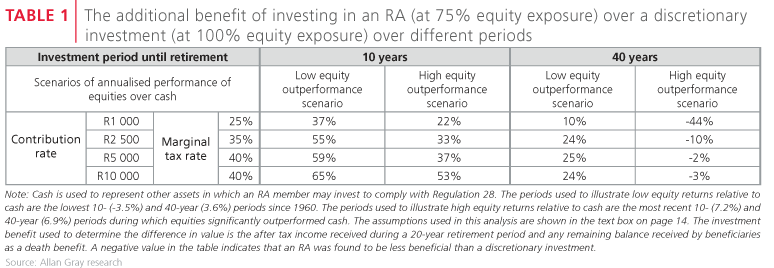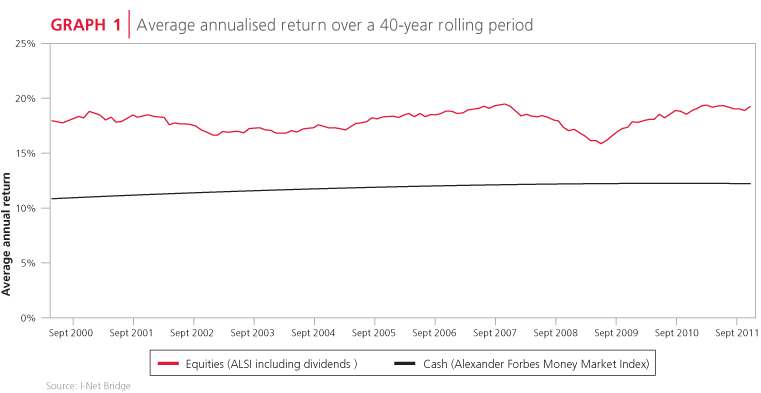Previously, retirement funds were considered an obvious choice for many investors due to the tax benefits they afforded. However, changes to Regulation 28 of the Pension Funds Act, which limit an individual’s exposure to certain asset classes, have brought the choice of product into question for some investors. Christo Terblanche and Wanita Isaacs compare saving for retirement via the Allan Gray Retirement Annuity Fund to saving with a discretionary unit trust investment.
The tax benefits of investing in a retirement annuity fund (RA) have meant that to date they have been a popular choice for retirement savers. Many RAs, including the Allan Gray Retirement Annuity Fund, offered the additional benefit of investment flexibility, allowing individual investors to be fully invested in equities by applying investment limits only at the fund level. Some of our clients have expressed concern that the recently revised retirement fund investment regulations put them at a disadvantage as they cannot invest fully in equities (see the text box ). These investors could forego the tax benefits of RAs and avoid their restrictions by rather investing directly into unit trusts, also known as ‘discretionary’ investments, to try to maximise their long-term returns. This raises an important question: do the benefits of an RA outweigh the potential for higher returns from full exposure to equities? The answer to this question depends on your circumstances, most significantly your investment period and your marginal tax rate, as well as the long-term outlook for equities.
The tax benefits of an RA outweigh the investment restrictions over all but the longest periods
A critical assumption we have made, is that an RA will not cost an additional layer of fees. This is true for the Allan Gray RA and for many others in the market, but is certainly not universally true. Under this assumption, and those shown in the text box on, our analysis reveals that at all marginal tax rates and retirement income levels, the benefits of an RA are only significantly outweighed by a discretionary investment in the very long term, even if equities outperform significantly relative to other assets.
IT IS ALSO IMPORTANT TO REMEMBER THAT AN RA ENSURES THAT YOUR SAVINGS ARE KEPT FOR YOUR RETIREMENT
During the fi rst quarter of this year, the Minister of Finance introduced revised investment requirements for retirement funds (Regulation 28 of the Pension Funds Act). One of the key objectives of the regulation is to ensure retirement fund investments are adequately diversifi ed and it aims to achieve this by prescribing the maximum exposure that members may have to certain asset classes (e.g. 75% in equities, 25% in property, 25% in foreign assets). Previously Regulation 28 only prescribed maximum limits at retirement fund level, meaning that members could potentially select asset class exposures of their choice outside these limits to make up their investment account, provided that the retirement fund’s total holdings complied with the regulation across all of its members.
For more information on the amendments to Regulation 28 and the impact on investors, please refer to our article ‘Making sense of the revised retirement fund regulations’ in Quarterly Commentary 2, 2011.
Table 1, below, shows that over a 10-year period, in which equities outperform cash by just over 7% per year on average (as they have during the last 10 years), the tax benefits of an RA are not outweighed by a discretionary investment. On the other hand, if equities significantly outperform other assets over very long periods, compound growth on the excess returns that are possible from full equity exposure can make a discretionary investment more attractive.

The higher your income tax rate, the more tax savings are possible in an RA. Assuming a contribution rate of 7% of income, the tax benefits of contributing to an RA increase with your contribution rate. Table 1 shows that a discretionary investment may be more beneficial than an RA at all contribution rates over a 40-year period in which equities outperform other assets by almost 7% per year. But as contributions increase, the benefit of the discretionary investment decreases significantly. For example, our analysis showed that over a shorter time period of 30 years at the same level of equity return, a discretionary investment would only be better for investors with low marginal tax rates (of 30% or less), who we have assumed would be contributing at rates of R1 500 per month or less.
It is important to think about the long-term outlook for equities when planning for retirement
Graph 1 shows the average return per year for equities compared to cash for 40-year rolling periods ending at the dates shown on the horizontal axis, since 1960. The lowest long-term equity performance relative to cash occurred in the 40 years up to April 2009, when equities outperformed cash by just 3.6%. Over a similar return period, an investor at any of the contribution rates shown in Table 1 would be better off in an RA. Equities would need to outperform other assets by at least 5% over 40 years to make a discretionary investment better than an RA even for an investor at the lowest marginal tax rate in our analysis, which corresponds to a contribution of R1 000 per month.
Investor behaviour affects investment returns
As shown in Graph 1, historically, equities have consistently outperformed other assets over the very long term. On average, over periods of 10 years or longer, equities have delivered at least 6% more than cash per year. But the potential for higher returns comes at the cost of greater risk, in the form of short-term volatility and, therefore, the possibility of losing money by selling at the wrong times. For example, in the 10-year period to July 2004, equities delivered returns of 3.5% less than cash per year. If you are considering a discretionary investment for your retirement savings because you believe that the outlook for equities over the very long term is favourable, your ability to stay invested and to tolerate ups and downs in the market should play an important role in your decision.

Investors who may be comfortable with full equity exposure while equities are outperforming may become more risk averse during downturns in the market and may wish to switch to more conservative unit trusts. Switching involves selling units, which increases the impact of capital gains tax (CGT) in a discretionary investment. The possible advantage of a discretionary investment over long time horizons, as discussed above, is based on an investment strategy of buying into equity unit trusts and holding them for the duration of the investment. An investor willing to wait out the ups and downs can benefit in the long term, but must be comfortable with often dramatic volatility, including periods of underperformance that can last for many years.
When comparing RA and discretionary investments, it is also important to remember that an RA ensures that your savings are kept for your retirement, while a discretionary investment allows you to withdraw your money at any time. Investors saving for retirement in a discretionary investment might encounter significant life events such as job changes, buying a new home or starting a family, which could tempt them to withdraw some or all of their savings. Aside from depleting their provision for retirement, early withdrawals could also reverse the potential long-term benefits of higher equity exposure by decreasing the effects of compound growth and increasing the impact of CGT on the investment. On the other hand, investors who are confident of their ability to meet their retirement needs may see less value in this withdrawal 'straitjacket'.
If you have a very long time horizon and therefore decide to invest directly into equity unit trusts, but you then withdraw your money after a 10-year period of equity underperformance relative to other assets, you can quite easily reverse the advantage your discretionary investment might have afforded, and end up being worse off than had you invested in an RA over the same time period.
An RA remains an effective investment product for most investors saving for retirement
Although compliance with Regulation 28 requires lower exposure to equities than some investors prefer, the tax efficiency of an RA, combined with the lower exposure to investment risk, makes it an effective way to save for retirement for most investors.
Investors with lots of time to save and who are confident that equities will significantly outperform other assets may do better with a discretionary investment. However, these investors need to have the discipline to leave their money invested and to stick to their investment strategy over the long term. It is important not to underestimate the temptation to withdraw; an RA offers the security of knowing your retirement savings will be kept for your retirement.
FOR MANY LONGTERM SAVERS, THE ANSWER MAY BE A COMBINATION OF DISCRETIONARY UNIT TRUST INVESTMENTS IN AN RA PRODUCT WRAPPER
Our analysis required us to make assumptions that hide important differences between individual investors’ circumstances. For many long-term savers, the answer may be a combination of discretionary unit trust investments and investments in an RA product wrapper. If you are uncertain as to what is most suitable for you we suggest you consider speaking to an independent financial adviser.
Investment strategy and returns
We assessed the effect of contributing towards your retirement over different investment periods, using different return
scenarios. The return scenarios are based on actual historic equity and cash returns for rolling 10-, 20-, 30- and 40-year periods
since 1960. Within the discretionary investment we assumed a consistent investment strategy of full equity exposure for the
whole investment period, including retirement. In the RA we assumed 75% exposure to equities pre-retirement (the maximum
allowed in terms of Regulation 28) and full equity exposure on transfer to a living annuity at retirement.
Contribution levels
When you invest directly into unit trusts, you use money that has been taxed at your marginal income tax rate. In comparison,
you do not pay tax on your contributions to an RA. Currently up to 15% of the portion of your income not used to calculate
contributions to an employer’s retirement fund is tax deductible. At higher tax rates you are able to contribute more to an RA
than to a discretionary investment. Assuming contributions at 7% of salary, we tested different pre-retirement contribution
rates, and for each RA contribution example the income tax tables were applied so that the corresponding discretionary
contribution is lower. The contribution rate examples shown in Table 1 assume contributions escalated at 10% per year.
Withdrawals and estate planning
Within an RA you are not taxed on either interest or capital gains and at retirement from an RA you are entitled to take up to
one-third of your investment as a cash lump sum, the first R315 000 of which is currently tax free. The rest of your investment
must be transferred to a pension-providing vehicle such as a living annuity. For the purposes of this investigation, we assumed
the maximum tax-free amount was taken at retirement and we took future income tax into account on the income drawn
during retirement.
In a discretionary investment you are subject to capital gains tax (CGT) whenever you sell units. We assumed no switching
between unit trusts and no withdrawals before retirement. During retirement, for each living annuity income level we assumed
the same amount drawn from the discretionary investment as gross income. We calculated CGT on this amount, assuming that
the investment is the only source of income and taxable capital gain during retirement.
At the end of the assumed 20-year retirement period the balance remaining in both the discretionary investment and the RA
was treated as a cash withdrawal for the benefit of beneficiaries.
Although Regulation 28 also limits an investor’s exposure to foreign investments, in this investigation we assumed only local
investments.